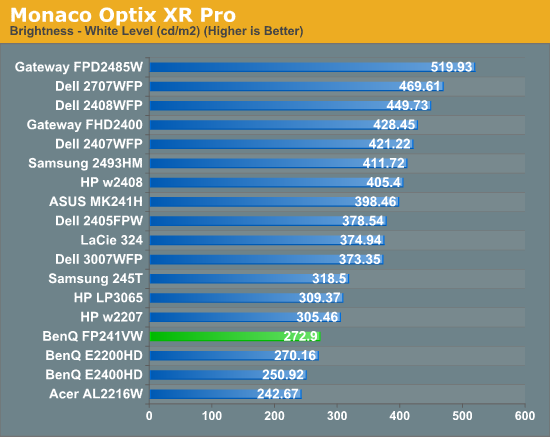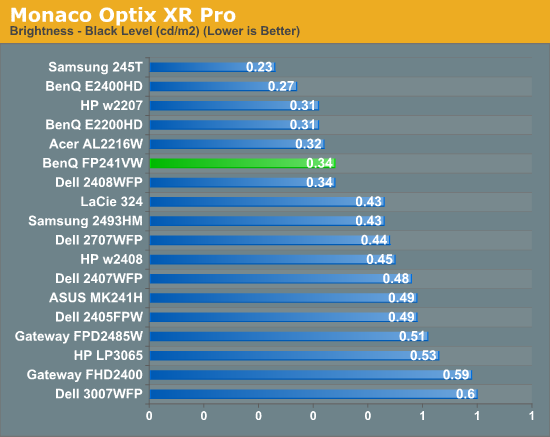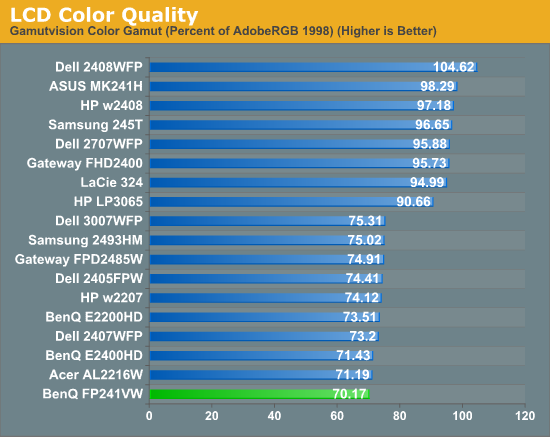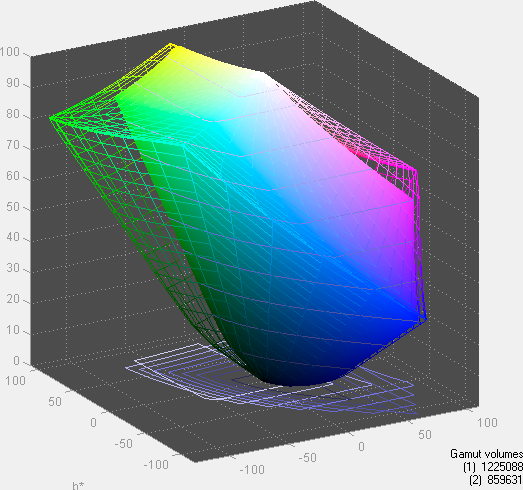Brightness and Contrast Ratio
For the brightness, contrast, and color accuracy tests, we depend on a hardware colorimeter and software to help calibrate the displays. We use a Monaco Optix XR (DTP-94) colorimeter and Monaco Optix XR Pro software, and we also test with ColorEyes Display Pro. Results in nearly every case have been better with Monaco Optix XR Pro, so for this article we're skipping the ColorEyes Display Pro results. We didn't perform a complete evaluation of the FP241VW, so we're missing maximum/minimum brightness results, but in general the display performs similarly to other LCDs.



Don't pay too much attention to the white/black graphs, as they are merely reference points for how the displays perform at certain settings. Like many other LCDs, the FP241VW has a "normal" brightness level of ~270 nits, which is more than sufficient and is actually brighter than what most users prefer to use in an office environment. You can reach the advertised 500 nits brightness if you adjust contrast and color levels as well. More important than brightness levels is the contrast ratio at the various settings. We measured a contrast ratio of 800:1 with the FP241VW, which is a decent result placing it in the lower mid section of our charts. While higher scores are better, in reality anything above 500 is sufficient for most users (i.e. the HP LP3065 that we like is at the bottom of the chart). Also, we wouldn't worry about any advertised dynamic contrast ratio numbers - at least not if you want consistent colors.
Color Gamut
Below is a comparison of color gamut for the LCDs we've tested. We use Gamutvision, a utility developed by Imatest LLC, to calculate color gamut. We compare the color profiles of the LCDs to the Adobe RGB 1998 color profile and report the results as a percentage - higher being better.


So far, color gamut has generally fallen into one of two categories: either +/-95% or +/-75%. Color gamut is determined almost exclusively by the backlighting, and the BenQ FP241VW falls short of other high-end LCDs in this area. In fact, it's at the bottom of the chart (though the difference between 70% and 75% isn't something you're likely to notice, so the bottom grouping essentially is a tie). For the original price, we would expect better, and if AU Optronics updates this particular panel we would definitely like to see a better backlight. Ideally, what we would like to see from more manufacturers is the use of LED backlighting - you can get extremely high color gamuts using RGB LEDs, and power requirements are also lower than traditional CCFL backlights. It's important to keep things in perspective, however: 70% may seem very low, but if you are using the standard sRGB profile (Windows' default) these LCDs look fine. It's only in applications like Adobe Photoshop with its expanded color space that you might notice a difference between the display color gamuts.










114 Comments
View All Comments
erple2 - Wednesday, June 17, 2009 - link
I bought the hp 2475w to replace my old Dell 2001FP model. I don't have any complaints about it. The color is better than the Dell was. I wound up using both monitors, however, as I have the space on my desktop for both of those monitors. It's nice to have the side monitor (relegating the 2001FP to side monitor ... heh heh) for "other tasks" while focusing on the main monitor. Plus, they're about the same vertical size.Again, I haven't noticed any real complaints with the 2475w beyond what I'd also complain about the 2001FP. In fact, the brightness appears better and more uniform.
Mastakilla - Wednesday, June 17, 2009 - link
Are you crazy?I (and I hope smarter people allow me to say "we") do NOT want high color gamut, because there is simply no support for it...
until it is supported on OS level, 99% of the applications that 99% of the people use simply look like crap :(
stop supporting this wide gamut bullshit please!!
I want to see what I'm supposed to see and not some over saturated crap
and even if you are a graphics artist using correct wide gamut hardware / software: what is the point in it? 99% of the people will see the image wrong anyway...
haplo602 - Wednesday, June 17, 2009 - link
graphic artists prepare photos for PRINT not web viewing :-)also a proper wide gamut monitor has an sRGB mode where the colors match (or should match) sRGB, no oversaturated colors.
bigboxes - Wednesday, June 17, 2009 - link
The OP is misinformed. A wide color gamut is very important for color accuracy. Maybe not for the casual user, but definitely to the content creator.The0ne - Thursday, June 18, 2009 - link
Hence that's why I think most of the users commenting here aren't really in the business to even use, appreciate or know what they're getting. It's all about having the best but now knowing what to do with it. That's just my opinion of course.Now before anyone starts getting upset, I am still in the printing business dealing with credit cards and checks. I can tell you from numerous research and seminars that most people really don't care, don't know or don't appreciate what some of these technologies provide. And rightly so because it's a niche market.
10e - Wednesday, June 17, 2009 - link
You said "In the case of the FP241VW, color accuracy and color gamut are lower than average, but that a better backlight could address that shortcoming."I'd agree the factory accuracy of the FP241VW is not good, but the fact that it was always a standard gamut display is/was an advantage. We get caught up in numbers and forget that in regards to gamut, for 99% of the users out there sRGB gamut is more than good enough, and is preferable to the over saturated reds and greens of wide gamut panels, which is something that so far even Windows 7 has not been able to properly address.
10e - Wednesday, June 17, 2009 - link
In my experience the Samsung S-PVA panels used in these monitors lag: Dell 2408WFP, 2709W, Samsung 245T, 275T Plus. There is noticeable input lag where the mouse cursor plays "catch up" with what the mouse hand is doing. I had an FP241VW and it never displayed this characteristic in DVI or VGA. It goes to show that some people will notice it, and others won't.darklight0tr - Wednesday, June 17, 2009 - link
I understand, but it is getting tiring to constantly get beaten over the head with that info, as is done in this article.I think PVA gets a bad rap, and I think the lag has more to do with the image scalers than it does with the panel technology itself. Just look at the reviews for the S-IPS 3008WFP. There are the same complaints from a few users about input lag on that display, and one of the main changes from the 3007WFP was the addition of an image scaler. All of the PVA displays you mention have scalers as well.
That said, despite all of the hype you read on the Internet over lag, there are probably tons of very happy PVA users (including myself) playing games on their PVA displays, oblivious to any lag.
jabber - Thursday, June 18, 2009 - link
Indeed I have two Samsung 214T 21" 4:3 PVA panels and they are super sharp and I see no ghosting or 'catch up' whatsoever.Running through COD4/BF2/EVE etc. etc.
As stated above I dont think its the panels. I reckon its the case of more expensive panel so often the manufacturer will cut corners on the other electronics inside to make it hit a price point.
PVA's are fine. However, as with any monitor purchase, if you are serious about screen quality...do your homework!
jabber - Wednesday, June 17, 2009 - link
Been using PVA screens pretty exclusively for gaming for around 3 years now. Havent noticed or seen any performance/screen lag issues in all that time.Maybe you are thinking back to the turn of the century screens?
Certainly isnt an issue in my opinion.